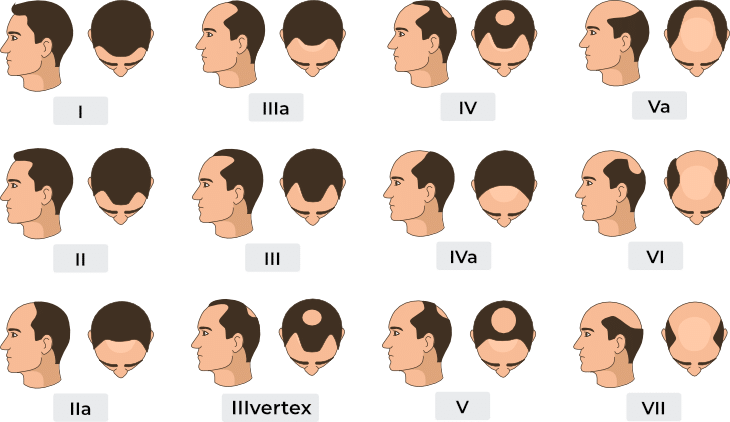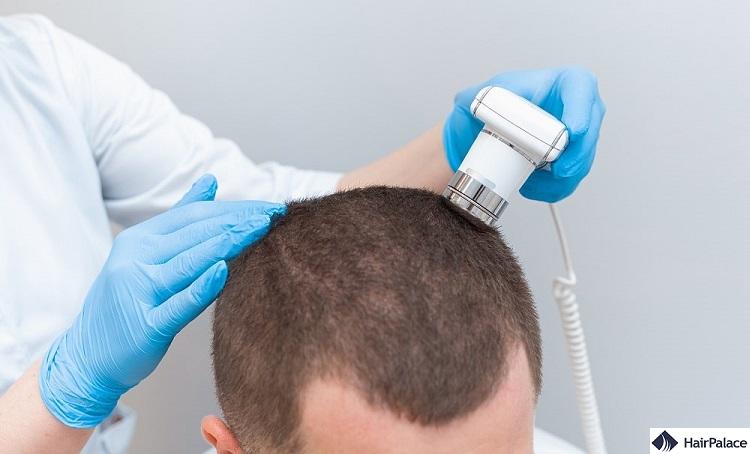Receding Hairline: All You Need to Know

A receding hairline is a form of hair loss where the hairline gradually moves backwards, often forming an M-shaped pattern.
It is typically caused by genetic factors and hormonal changes, particularly an increase in dihydrotestosterone (DHT).
Treatment options include medications like minoxidil and finasteride, hair restoration surgeries, and lifestyle modifications to slow the progression.
We’ll explore how to spot a receding hairline and go over the causes and treatment options to help you fix your receding hairline once and for all.
- What is a receding hairline?
- Signs of receding hairline
- What causes a receding hairline?
- What does a receding hairline look like?
- How do experts diagnose an early receding hairline?
- Receding hairline men treatment
What is a receding hairline?
A receding hairline is one of the most common signs of hair loss, particularly in men. Characterized by the hair starting to thin and pull back from the forehead.
At its core, a receding hairline refers to the loss of hair from the temples and the forehead, creating a ‘M’ shaped pattern over time.
A receding hairline can affect men at any post-puberty age, hair thinning could start as early as the late teens or early 20s.
Usually, though, most men will notice at least some recession by the time they reach their late 30s.
Signs of receding hairline
Most receding hairline types tend to begin above the temples and advance over the top of the scalp.
One common pattern is a ring of healthy growth around the back and sides of the head with thinning hair on top.
Hair may grow in patches, such as an island in the centre of the scalp.
However, you could also retain healthy growth in the middle of the scalp while hair loss proceeds from above the temples, forming a V-shaped pattern known as a “widow’s peak.”

For women, the back and sides of the head usually retain their hair while the centre part expands across the top of the scalp.
For some postmenopausal women, this might be caused by frontal fibrosing alopecia, a condition that mainly affects the hairline and can occur alongside female pattern baldness.
What causes a receding hairline?
There can be several reasons why your hairline is receding.
The average human scalp contains around 80,000 hairs. It’s believed that people lose between 50 and 100 hairs each day through this cycle, which is considered normal hair loss.
But you could lose considerably more for the following reasons:
- Male pattern baldness: Androgenetic alopecia (or male or female pattern hair loss) is the most common cause of hair loss at the hairline.
- Genetics You may have genetic hair loss — you’ll be more likely to lose hair if someone in your family has been impacted by female or male pattern baldness.
- Stress or illness Hair loss related to stress or illness is known as telogen effluvium. This can come on after a particularly difficult period, but you may stop losing hair if you reduce your stress levels.
- Medications or medical treatments: Various medications and treatments can contribute to a receding hairline, such as some for blood pressure.
- Styling: Certain hairstyles can contribute to a receding hairline, such as pulling the hair back in an excessively tight ponytail. This can cause traction alopecia.
- Hormone changes: Hormonal changes may trigger hair loss in men and women. For example, menopause can contribute to shedding (though not always at the hairline).

What does a receding hairline look like? (Stages)
A receding hairline is often the first sign of male pattern baldness and progresses through several stages before it reaches its distinct M-shape.
With the help of the Norwood scale, we can distinguish the following receding hairline stages:
- Stage I – No sign of hair loss
- Stage II – Receding starts at the upper corner of the left and right temples
- Stage III – Hair loss at the temples becomes more prominent, and the hairline forms a noticeable M-shape or widow’s peak
- Stage IV – Balding hairline affects the crown or the mid-front
- Stage V – The hair recedes further, there may be a band of hair remaining between the front and the crown
- Stage VI – Significant hair loss, the crown recedes further back
- Stage VII – Pattern hair loss is complete, with a band of hair at the back and sides of the head

How far will a receding hairline go?
A receding hairline may be the beginning of full baldness on top of the scalp or a mild change that makes a minimal impact on your appearance.
You may never experience further hair loss, but it can be challenging to predict.
And while you may get a glimpse into your future if you look at a parent or older sibling’s hairline, there are no guarantees.
How do experts diagnose an early receding hairline?
If you want to know how to tell if your hairline is receding, consult a healthcare provider.
They’ll review your medical and family history and ask about any medications you take.
One method they use to evaluate hair loss is the “pull test,” where they gently tug on a few hairs to see how many come out and how easily they detach from the scalp.

Doctors may also conduct a scalp biopsy to check for infections or underlying conditions causing hair loss by removing a small tissue sample.
Blood tests might be done as well to detect common conditions like thyroid disease that can contribute to a receding hairline.
These tests help diagnose receding hairline signs and treat the root cause of hair thinning.
Receding hairline men treatment
Currently, there are no treatments available to stop a receding hairline permanently.
Your doctor may discuss hair loss treatments to slow down or even stop your hairline from receding further temporarily, depending on the cause and the severity of hair loss.
It’s always best to get a diagnosis as fast as possible and start treatment at the earliest signs of a receding hairline to achieve the best results.
Potential receding hairline treatment options include:
- Minoxidil
- Finasteride
- Hair transplant
- PRP
Receding Hairline FAQ
Yes — a receding hairline can be reversed in most cases. However, treatment is determined by the cause of hair loss: for example, minoxidil (Rogaine) is one of the only medical solutions for male and female androgenic alopecia available.
No treatment is guaranteed to stop hairline recession. However, various treatments and practices can help you maintain your hair’s health for as long as possible.
Androgenic alopecia is a hereditary type of hair loss and is one of the most common reasons for receding hairlines. You’re more likely to develop hairline recession if you have a family history of baldness.
While there’s no direct cure for a receding hairline, various medications can slow its progression and encourage regrowth. These include minoxidil, finasteride or dutasteride, corticosteroids, anthralin, essential oils, hair transplants, and laser therapy.
To prevent a receding hairline consider using gentle hair care products, avoiding tight hairstyles, eating a balanced diet, managing your stress levels and getting help from a healthcare professional.
Certain medications such as finasteride or minoxidil may slow down the progression of your hair loss, but there is no way to completely stop the process.
Look at photos of yourself from a few years ago and compare them to recent ones. Changes in hairline position can indicate recession.
A receding hairline can be an early sign of male pattern baldness, but it doesn’t necessarily lead to complete baldness.
A receding hairline due to male pattern baldness won’t naturally grow back, but treatments like minoxidil can help restore it. However, the only long-lasting solution to the problem is a hair transplant.
Your hairline is likely receding due to genetics and hormonal factors, most commonly male pattern baldness. This condition is influenced by sensitivity to dihydrotestosterone (DHT), which gradually shrinks hair follicles. Stress, poor nutrition, or certain medical issues can also accelerate the process.
A receding hairline happens because hair follicles in specific areas of the scalp become sensitive to DHT, a byproduct of testosterone. Over time, these follicles shrink, produce thinner hairs, and eventually stop growing. The pattern usually starts at the temples and moves backwards.
Last medically reviewed on September 18th, 2025
- Ho, C., & Hughes, J. (2017, March 6). Alopecia, Androgenetichttps://www.ncbi.nlm.nih.gov/books/NBK430924/
- Chan L, Cook DK. Female pattern hair loss. Aust J Gen Pract. 2018 Jul;47(7):459-464.https://pubmed.ncbi.nlm.nih.gov/30114864
- Manabe M, Tsuboi R, Itami S, Osada SI, Amoh Y, Ito T, Inui S, Ueki R, Ohyama M, Kurata S, Kono T, Saito N, Sato A, Shimomura Y, Nakamura M, Narusawa H, Yamazaki M., Drafting Committee for the Guidelines for the Diagnosis and Treatment of Male- and Female-Pattern Hair Loss. Guidelines for the diagnosis and treatment of male-pattern and female-pattern hair loss, 2017 version. J Dermatol. 2018 Sep;45(9):1031-1043.https://pubmed.ncbi.nlm.nih.gov/29863806
- Sperling LC, Sinclair RD, El Shabrawi-Caelen L. Alopecias. In: Bolognia JL, Schaffer JV, Cerroni L, eds. Dermatology. 4th ed. Philadelphia, PA: Elsevier; 2018:chap 69.
- Azar, Reza Pashmineh, et al. "Asymmetry of the Receding Hairline in Men With Early Androgenetic Alopecia." Journal of Cutaneous Medicine and Surgery 20.6 (2016): 546-549.
- Wolff, Hans, Tobias W. Fischer, and Ulrike Blume-Peytavi. "The diagnosis and treatment of hair and scalp diseases." Deutsches Ärzteblatt International 113.21 (2016): 377.

